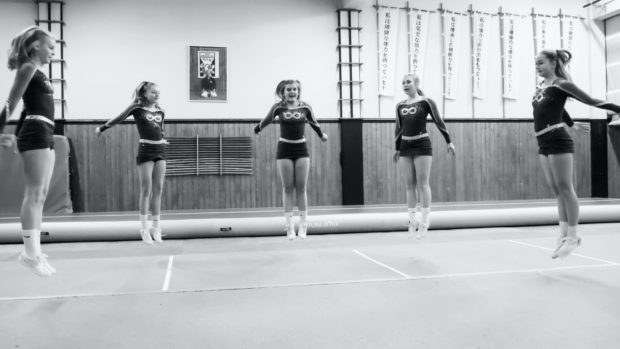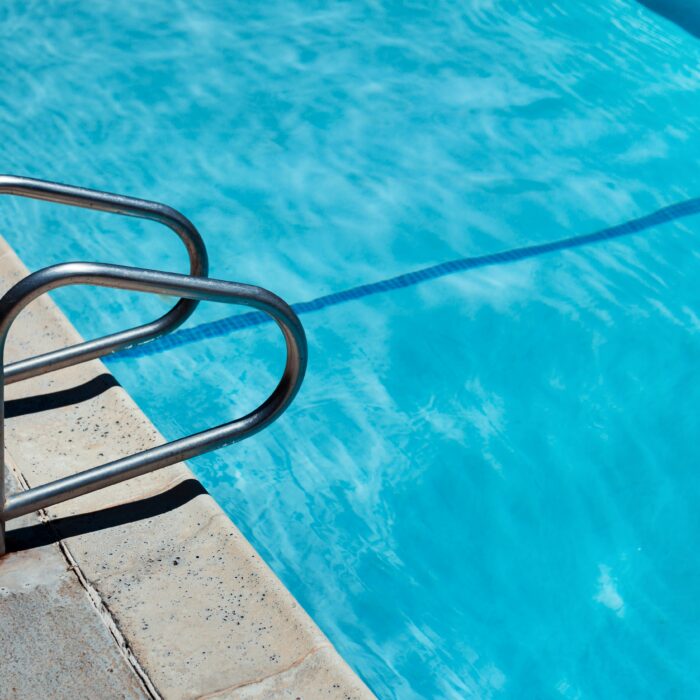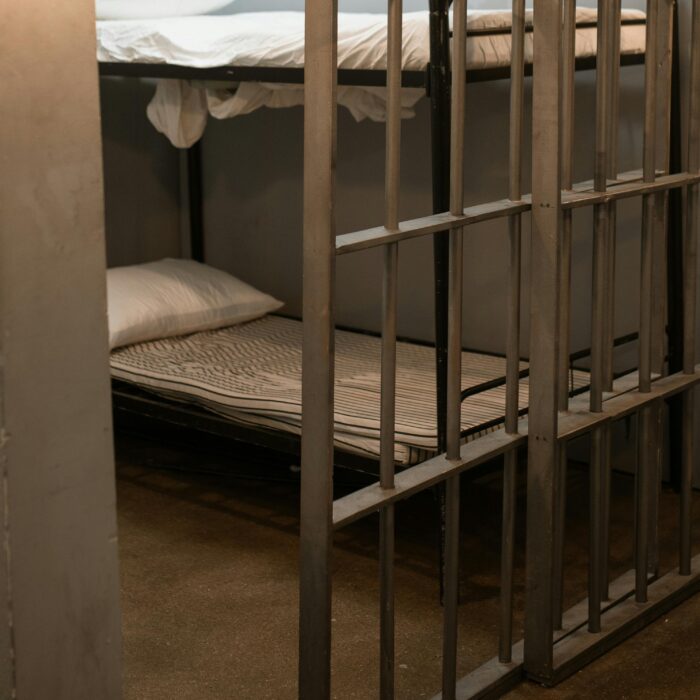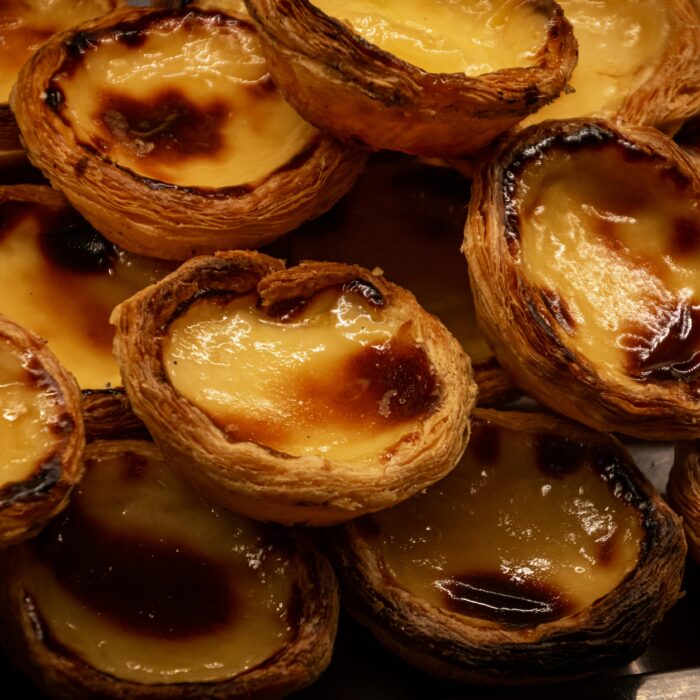You have no items in your cart. Want to get some nice things?
Go shopping
As a kid, I knew football was on TV when I smelled Mom’s cheese dip cooking in the kitchen. In a pot on the stovetop, she’d melt a golden brick of Velveeta cheese and stir in a can of Rotel, a mild blend of tomatoes and green chilies. Sometimes before games, I’d help her make pigs in a blanket by wrapping cocktail weenies in little sheets of canned biscuit dough. We’d swaddle sausages in their own Pillsbury blankies and then bake them to a crisp buttery brown. When a big game was on, our coffee table doubled as a snack buffet. I’d be happily dunking a tortilla chip into my bowl of cheese dip when Mom would leap off the couch, throw her hands in the air and squeal, “Be there be there be there!” I’d snap my head around to watch her performance as she bounced around the living room. These moments of intense excitement happened when Troy Aikman threw a long pass to Michael Irvin. Mom’s display was like a prayer to help the receiver catch the ball. For my money, Mom put on the more entertaining show.
In the 1990s the Dallas Cowboys won three Super Bowls, two of them back to back. I was six for the first win, seven for the second, and one day shy of nine for the third. Growing up in North Texas, I’d walk through the bakery section of the grocery store and see cakes decorated with the players’ names spelled out in icing. I grew up with the understanding that the Cowboys were the greatest team, from the greatest state, from the greatest country on earth, and I believed wholeheartedly that I lived in the bull’s-eye of excellence. It did not cross my mind that that anyone would root for the other teams. Cheering for the Cowboys was an act of patriotism, and to cheer for a different team would be un-American.
*
I followed my best friend and her parents through a crowd of teenagers at the high school’s stadium. Students hung out in clusters under the bleachers where they drank canned sodas purchased from the concession stand. I didn’t recognise faces: These were high schoolers. My friend and I were in intermediate school, which was for students in the in-between years: We were too old for elementary school but not old enough for middle school.
When we emerged at the front of the stands, the field revealed a game in progress, played on real grass under high powered stadium lighting. As we clomped up the wooden bleachers to our seats, my eye was drawn to an army of sparkly costumes which twinkled under the artificial lights. Beautiful girls with bold red lips and glittery eyelids wore black cowgirl hats and polished cowgirl boots. They smiled bright white smiles and chatted with each other as they walked out of the bleachers toward the field.
In Texas everything is bigger, including the halftime show. The Lone Star State was the first to step up the pageantry of football games by adding dancing girls to the lineup of halftime entertainment. Regardless of the school’s mascot, this group of girls, called a drill team, usually wears a combination of Western wear which can include accessories like fringe, gauntlets, cowgirl hats and boots. A signature of the Texas-style drill team is a kickline, where girls stand in one long line, link arms, and kick high enough to bring their boots to the rim of their hats.
We found our seats in the stands, and the halftime show started. The band began to play and the pretty girls with the flashy costumes strutted to the centre of the field. As they danced, they shook pom-poms and changed formations with precision. I noticed that a few girls dancing in the front had uniforms that were different from the rest of the team. While the majority of the girls wore black uniforms laced with red sequins, the girls in front had silver sequins. “Why are the girls in front wearing silver?” I asked my friend. “Those are the officers,” she said. “They’re the special ones.” As I watched the team transition into a new formation, link arms and start high kicking, I formed an idea. I would be one of those special ones.
*
I was on drill team all four years of high school, and I did become one of the special ones. I made it all the way to the head position, front and centre for pep rallies and halftime performances. I was proud to wear a band of silver sequins around my black cowgirl hat. I took a special joy in high kicking on the 50-yard line, the centre of the field. I’d kick high enough and hard enough to blot my red lipstick on my beige tights. I wore those stains as a badge of honour, a symbol of flexibility and strength.
At the start of a game, the band would play while the drill team girls danced in two long lines, smiling to the stands and shaking our pom-poms, creating an aisle for the football boys to run through to get to the field. Their parents shook obscenely loud noisemakers which they had fashioned from giant cannisters filled with marbles and the like. Grown men were required for lifting and shaking these weighty rattling contraptions. Air horns rounded out the cacophony of noise meant to support the boys as they ran onto the field. The racket intensified when they scored touchdowns. It was so loud that during my drill team tenure, the homemade noisemakers and air horns were banned from games.
My first drill team director was in her 20s and had bleach-blonde hair that touched down just below her shoulders. She always had a pristinely powdered complexion, and she wore wine-coloured lipstick. We called her Coach, which was informal and more familiar than calling her Miss Last Name, which was standard in the drill team world. Calling her Coach belied the fact that everyone was intimidated by her, including our parents.
Coach would get irritated with us for coating ourselves in glitter. Once at a game, my teammates were in the stands in front of me, hosing each other down with spray-can glitter. We girls had established that gold glitter looked best in blonde hair, sliver looked great in dark hair, and multicolour was an all-around improvement for anything it would stick to. Coach turned around from her perch at the front of the stands and shouted, “You girls are sparkly enough!” She left her position after my first year on drill team to be a Dallas Cowboys cheerleader.
I tried to be a good Southern girl who pays attention to the game and cheers for the boys. I knew that in order to take a real interest in the game, I needed to understand its rules. I am going to learn football. I am going to learn football, I repeated over and over in my head like a mantra. The truth was that I couldn’t care less about the sport, and to make matters worse, there were layers of distractions between me and the players, and my natural inclination was to watch everything else. My attention was primarily drawn to the cheerleaders, who were often directly in front of us on the track around the field while we drill team girls sat in a block formation in the stands. Their cheers involved choreographed dance moves as well as jumps, tumbling, and stunts. How was I supposed to pay attention to guys knocking each other around when acrobatics were in progress right in front of me? My situation was like doing homework with the TV on: I couldn’t focus on studying while there was a good show on.
I’d also watch the people in the stands. Adults balancing trays loaded with hotdogs, nachos, and sodas carefully inched toward their seats, trying not to spill their concessions on a spectator’s head. Little kids, utterly uninterested in football, played a game of their own. They chased each other up and down the metal steps, their stomping creating a rumbling thunder as they played tag.
As the sun dipped behind the bleachers, the giant stadium lights would blink to life and create a stage for a variety of bugs that would swarm the lights, anxious for their moment in the spotlight. They were reckless, bumping into each other as they pirouetted around the light poles.
The whistle would blow. Oh crap. I was supposed to be studying the plays. I didn’t notice that my attention had wandered. You know something’s truly not for you when the competition is watching bugs buzz around a light pole and the bugs win.
I had a crush on number 99, a tight end, but that was a far as my interest in the game went. He had dark hair, pale blue eyes, and beautiful teeth, but these attributes were only visible with his helmet off, so you can see how his playing football got in the way of me admiring him. In his uniform and helmet, it was difficult to pick him out on the field, and I’d lose interest. I never did find out what a tight end does.
During my junior year, our captain would turn around to us in the stands and yell, “Ladies, we are a spirit organisation!” Upset whenever there was a lull in our cheering, she’d repeat this until I wanted to strangle her. I didn’t audition for the drill team with my spirit. I auditioned with turns, high kicks, and splits. I tried out so I could dance in front of an audience and wear sparkly costumes, not so I could feign interest in sports. But I came to understand that another aspect of the performance was to cheer for the boys, to clap, to yell, to congratulate them when they won, and to console them when they lost. Sometimes they would have tear-stained faces after a game. I thought it was weird that they cared so much. I didn’t.
The difference between football and drill team is that is the boys get to do their activity with no strings attached, while the drill team girls have to do theirs under the guise of supporting the boys. I can’t imagine them coming to one of our dance competitions, the quarterback standing up in front of the players yelling, “We are a spirit organisation!” and urging them again and again to yell louder for us. Football doesn’t pretend to care about drill team.
Once before a game, a football coach came barrelling out of my high school and whacked me with the door, which sliced through my boot and ignited a sharp pain along the side of my foot. He glanced at me but didn’t break stride. I’d been practicing a routine on the concrete outside the school because the dance space dedicated to the drill team was so small that we just used it as a dressing room. I hobbled for several steps and was able to more or less walk it off, but the gash in my boot remained. I danced in those boots all four years of high school, all the way through my senior year as captain. Every time I tried to polish my boots to a pristine, like-new white, I ran my fingers along the indentation, where the rubbery material had been cut open, revealing grey fabric underneath that would not take hold of the white shoe polish that I heaped upon it.
*
During my time on high school drill team, I joined a dance studio in a neighbouring city. My studio was invited to perform alongside the Dallas Cowboys cheerleaders at a special holiday halftime performance at a Cowboys game. We watched the game from the sidelines while the players finished the second quarter. We’d be ready to hit our places as soon as halftime started. From a TV screen or the bleachers, even professional football games have always come off to me as small, insignificant. From the sidelines, it was a different game. The ground trembled in mini earthquakes under the enormous weight of the mammoth players tackling each other. If I could watch this close all the time, I’d stand a chance of learning the rules of the game. Out of the corner of my eye, I caught a glimpse of the Dallas Cowboys cheerleaders. They walked around the perimeter of the field in a single file line. I spotted Coach, and I watched a fan in the bleachers drape himself over the railing to lower his hand close enough for her to touch. She gave him a high five. She walked behind me, close enough for me to say hello, but I was too scared to do so.
*
In my high school every senior had to take a class called Destinations, a semester-long course that was supposed to help you figure out where you were going in life. In one assignment, we were supposed to shadow a person whose career matched what we wanted to be when we were older. Another girl who sat at my cluster of desks and I said we wanted to shadow a Dallas Cowboys cheerleader. My Destinations teacher, who was also a football coach at our school, gave us this are-you-kidding-me look. He said, “You know they only make $50 a game, right?” My friend and I shrugged it off. It was common knowledge that the cheerleaders were paid hardly anything at all. We knew what they earned was equivalent to a small gas stipend, but this tidbit of information was largely irrelevant to high school girls with no bills to pay. To wear an eye-catching uniform and dance in front of thousands of spectators seemed like payment enough. I ended up shadowing my high school drill team director for the class assignment. I was too afraid to even talk to my former drill team director, Coach, who was the only Dallas Cowboys cheerleader I knew.
*
I got talked into auditioning for the Dallas Cowboys cheerleaders after I graduated from high school. Don’t get me wrong, I planned on trying out eventually, but I first wanted to try out for a prestigious college drill team. I saw my dance career going in a particular order: high school, college, professional. But then one of my friends said she was too scared to go to the audition alone, so I agreed to go. The morning of the audition, I called her multiple times, but she never answered the phone. I’d already borrowed a bedazzled royal blue tryout outfit from a girl who had previously auditioned for the team. I’d already had my mom take my head shot and a full body shot for my application. I’d already had my hair colour touched up. I’d already gotten up super early to straighten my hair and put on performance makeup. I decided to drive to the stadium and go through with the audition by myself. When I arrived, I was greeted with a waiver that I was supposed to sign, agreeing that I could be shown on TV. I wasn’t aware that my audition was going to be part of a show. As I was pacing around, waiting for the audition to start, a producer grouped me with some other girls, put a camera in the middle of our huddle, and gave the directive: Talk. A few girls giggled uncomfortably. We didn’t know what to say. “Uh, I have some Skittles,” one girl said, pulling out a bag. “Do y’all want some?” She poured colourful candies into the palm of her hand and offered them around the circle, and we discussed which flavours we liked best. Needless to say, this footage didn’t make it into the final cut.
After a few hours of everyone filtering into the audition and signing their waivers, we were led out to the field. There were hundreds of women auditioning, and it took a while to get that many people from point A to point B. When all 600 or so of us had made it into the arena and were walking toward the seats, we were told to turn around, walk right back out, and try it again. We were given the directive: Look more excited. So all 600 or so of us turned around, walked out, and came back in to try it again with more excitement. On this round, girls cheered and clapped as they entered the stadium and saw the field for the “first” time. We were permitted to sit down and listen to instruction about how the audition day would go.
Back inside, we freestyled in groups of five. I introduced myself to a tiered panel of judges, looking the director in the eye as I spoke, feeling shaky, straining under the pressure of so many eyes and cameras on me. When the music came on, I pulled out all the stops, showing my flexibility with jump splits and high kicks, whipping my freshly bleached hair around. I was cut after the first round.
*
I continued my drill team career in college, which meant I had to keep faking interest in football. On my college team, the rookies had the unsavoury task of cheering for the duration of the games. While the veterans chatted with each other in the bleachers, rookies had to keep their eyes fixed on the game and cheer continuously. There were obvious things you could shout. “Let’s go, offense! Come on, defence!” But you can only chant robotically for so long before things get sloppy. By the second quarter, many girls would have slipped into something more stream-of-conscious. “Alright, cloud! That’s right, you block that sun! Come on, wind!” And by the third or fourth quarter, I sometimes heard the likes of “Yay bananas!” and “I love Christmas!” With a choir of voices continuously cheering, you couldn’t make out what any one girl was saying unless you were sitting right next to her, and as long as it sounded like we were cheering for the boys, no one cared what we were actually saying.
Toward the end of my freshman year, my team was invited to take part in the Cotton Bowl Hall of Fame induction. Our charter bus was waiting to shuttle us to the Cotton Bowl Stadium, and I was sitting in a row by myself next to the window, looking past my reflection of glossy red lips and tight blonde curls to the overcast sky. One of my teammates slung a tote bag onto the floor by my feet and plopped down into the seat beside me. She held up a half-eaten banana nut muffin. “Do you want to finish this?” she asked. Then she held up a newspaper. “You can read this if you want. I’m done with it.” She would be auditioning for the Dallas Cowboys cheerleaders in one month, so she was watching her weight (even though she was quite thin) and constantly brushing up on current events. A DCC is supposed to be the complete package: beauty and brains. I skimmed the newspaper and took bites of the muffin on our way to the Cotton Bowl Stadium.
It was an unusually cold April day at the stadium in Dallas. Unfortunately, the ceremony took place outside, and to make matters worse, I was one of the girls whose role was to stand at attention for the duration of the event, to be decoration behind the podium where inductees would give speeches after receiving their trophies. Wearing our traditional red shirts, white belts, and short blue skirts, we simultaneously symbolised both Texas and the United States. We carried red, white, and blue flags to further emphasise the patriotic colour scheme.
Usually we were cheering for the boys, but for this event we would be cheering for the men, men with distinguished careers as college football players or coaches. Normally we showed support by clapping and shouting from the stands, but today my group was showing support by doing our best impressions of statues. We gripped our flags and stared into the distance, smiling relentlessly. Raindrops began tapping our bare arms and legs. Audience members zipped up their jackets and pulled out umbrellas to shield themselves against the cold pellets that were intensifying. To fight the cold and to avoid passing out from standing still for so long, I began to focus on one body part at a time. I would crinkle my toes inside my boots, and then release them. Crinkle. Release. Repeat. Then I’d move up to my legs, tightening muscles in isolation, then releasing them. I would squeeze my fingers around the handle of my blue flag, then slacken my grip.
My teammate who passed me the muffin and newspaper on the bus was a trophy girl at the event. When an inductee was announced, she brought him his bronze statue. Since it had started to rain, her role changed slightly to include holding an umbrella over his head as he gave a speech.
Glued in place, still smiling in the cold rain, I began singing in my head, focusing on lyrics. Our school’s fight song became my own personal fight song. We’re all fighting Rangers . . . in rain or sunshine. I tried to keep the light in my eyes and resisted fading into a dull, mechanical smile.
It became a kind of side show to watch us girls stick it out in the cold rain. During his speech, a coach turned around to us and said, “We need to wrap up the ceremony so these girls don’t have to stand out here longer than they already have.” My muscles were exhausted, my hair was wet, and my makeup was sliding. I was thrilled to end the ceremony early. This Hall of Fame coach’s gesture came a long way from the high school coach who hadn’t apologised for hitting me with the door.
The next month the trophy girl became a Dallas Cowboys cheerleader. I’d catch glimpses of her on the televised show that follows the audition process. In one episode a young lady is asked to stand up in front her peers and some judges and answer a question about a player. When she is unable to answer the question, the director scolds her, saying there’s no excuse for meeting a player and then not knowing his name and his football background. No one auditioning counters with “I just want to wear the uniform and dance in front of thousands of people.”
*
One morning several years later, I turn on the news and see a panel of beautiful women, with perfect makeup and crisp professional attire, standing beside the famous women’s rights attorney Gloria Allred. The women, all former Houston Texans cheerleaders, sit before a microphone and read statements of allegations that range from not being paid for all the hours they worked, to being body shamed to being put in unsafe working conditions. One woman’s voice breaks as she describes being physically assaulted by a fan at a game. When the women finish their statements, Ms. Allred poses for a picture with the former cheerleaders. She holds up a tee-shirt with $7.25 printed on it, emphasising how much the women are paid per hour for their work. Minimum wage.
And it’s not just the Houston Texans cheerleaders. Several NFL cheerleaders from around the country have openly confronted football organisations about minimum wage violations. A former Dallas Cowboys cheerleader is among them.
I always had a half-assed dream of being an NFL cheerleader. It’s sobering to realise I grew up believing the epitome of success for a woman was to be exploited and undervalued, on the sidelines of the main event. I guess it worked out that I never made it all the way. I’d have had to make a living out of scraps and leftovers. I’d most likely have ended up like one of those women on the news, sitting beside Gloria Allred holding up the tee shirt with $7.25 printed on it.
Stefanie Fair-King
Stefanie Fair-King loves coffee, books, cats, and Oxford commas. She has degrees in English and philosophy. Stefanie participates in a writers group that has been meeting online since the beginning of quarantine, and she has written and published several pieces with the support of this group. She and her husband live in Texas.




